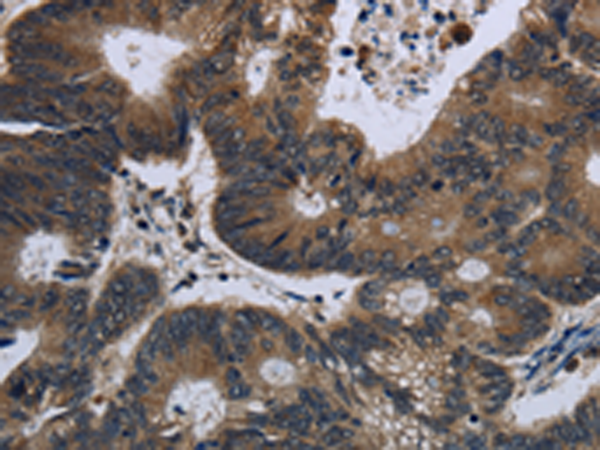

| WB | 咨询技术 | Human,Mouse,Rat |
| IF | 咨询技术 | Human,Mouse,Rat |
| IHC | 1/100-1/300 | Human,Mouse,Rat |
| ICC | 技术咨询 | Human,Mouse,Rat |
| FCM | 咨询技术 | Human,Mouse,Rat |
| Elisa | 1/2000-1/10000 | Human,Mouse,Rat |
| Aliases | GK1; GKD |
| Host/Isotype | Rabbit IgG |
| Antibody Type | Primary antibody |
| Storage | Store at 4°C short term. Aliquot and store at -20°C long term. Avoid freeze/thaw cycles. |
| Species Reactivity | Human, Mouse, Rat |
| Immunogen | Fusion protein of human GK |
| Formulation | Purified antibody in PBS with 0.05% sodium azide and 50% glycerol. |
+ +
以下是3-4条关于GK抗体(通常指与糖尿病相关的谷氨酸脱羧酶抗体,GAD抗体,或特定研究中提到的其他GK相关抗体)的参考文献示例及内容概括:
---
1. **文献名称**:*Autoantibodies to Glutamic Acid Decarboxylase in Patients with Type 1 Diabetes: A Practical Guide*
**作者**:Petersen, J.S., et al.
**摘要**:该研究系统评估了谷氨酸脱羧酶抗体(GAD抗体,常被简称为GK抗体)在1型糖尿病诊断中的作用,提出其在区分1型与2型糖尿病中的敏感性和特异性,并探讨了抗体水平与胰岛β细胞功能损伤的关联。
2. **文献名称**:*Islet Cell Autoantibodies and Progression to Diabetes in Non-Diabetic Subjects*
**作者**:Nakhooda, A.F., et al.
**摘要**:通过对非糖尿病个体的长期随访,研究发现GAD抗体(GK抗体)联合其他胰岛自身抗体(如IA-2抗体、胰岛素抗体)的存在可显著预测1型糖尿病的发病风险,强调了其在早期筛查中的价值。
3. **文献名称**:*GAD Antibody Prevalence and Association with Clinical Phenotype in Cuban Diabetes Patients*
**作者**:Cabrera-Rode, E., et al.
**摘要**:针对古巴人群的研究显示,GAD抗体阳性率与糖尿病发病年龄、家族史及胰岛素依赖性密切相关,提示该抗体可能作为特定人群的疾病分型标志物。
4. **文献名称**:*Molecular Mechanisms of GAD Antibody-Mediated Beta-Cell Dysfunction*
**作者**:Castano, L., Eisenbarth, G.S.
**摘要**:从分子机制角度解析了GAD抗体如何通过靶向胰岛β细胞内的谷氨酸脱羧酶,引发自身免疫攻击并导致胰岛素分泌障碍,为免疫干预治疗提供了理论基础。
---
**说明**:GK抗体在不同文献中可能指代不同靶点(如GAD抗体或特定糖酵解酶抗体),上述文献以常见的1型糖尿病相关GAD抗体为例。实际引用时需根据具体研究背景筛选,并核对作者及标题的准确性。
GK antibodies, a class of immunoglobulins, have gained attention in biomedical research due to their unique binding properties and potential therapeutic applications. Initially identified in studies targeting autoimmune disorders, these antibodies are characterized by their specificity for glycolipid or glycoprotein epitopes, particularly those involving glucose kinase (GK)-related structures. Their discovery emerged from investigations into immune responses in metabolic diseases, where aberrant glycan modifications on cell surfaces were linked to pathogenic mechanisms.
Structurally, GK antibodies often exhibit high-affinity binding domains shaped by somatic hypermutation, enabling precise recognition of conserved carbohydrate motifs. This feature has spurred interest in leveraging them for diagnostics, such as detecting disease-specific glycan biomarkers in cancers or neurodegenerative conditions. Additionally, their ability to modulate cellular signaling pathways—by blocking pathogenic protein-carbohydrate interactions—has positioned them as candidates for immunotherapy development.
Recent research explores engineering GK antibodies to enhance stability and reduce immunogenicity, with some progressing to preclinical trials for autoimmune and infectious diseases. Challenges remain in understanding their cross-reactivity and optimizing production methods. Nonetheless, their dual role as research tools and therapeutic agents underscores their growing relevance in precision medicine and glycobiology.
×